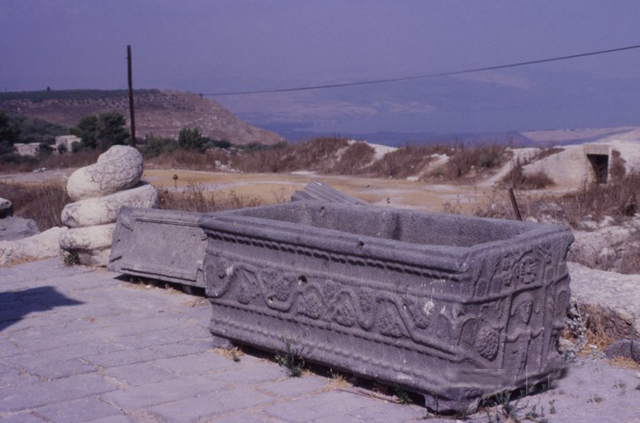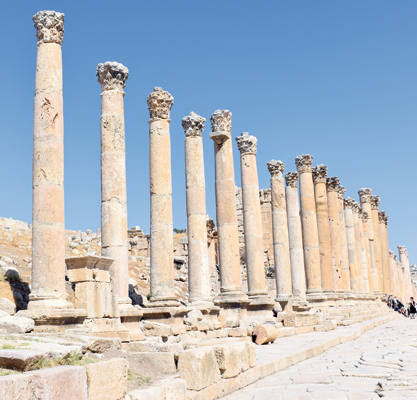You are here
Studying ancient shifts, modifications, developments of Levantine cities
By Saeb Rawashdeh - Apr 14,2024 - Last updated at Apr 14,2024

The tomb of Germani in Umm Qais (Photo courtesy of ACOR)
AMMAN — The ancient city of Gadara (modern Umm Qais) was developed during the Hellenistic and Roman eras and was part of the Decapolis. The settlement remained inhabited after the emergence of Islam during the 7th century AD, as the Arab geographers mentioned the name of Gadara during the Abbasid dynasty (750 AD - 1258 AD).
A few catastrophic earthquakes hit the Transjordan region in 749 AD and 1033 AD, as well as Jerusalem and the West Bank, and these events directly impacted the urban centres in the region.
During this period, a significant political transition occurred as the authority shifted from the Umayyad rule to the Abbasid rule, which relocated the centre of political power, moving it from Damascus to Kufa and Baghdad.
The period between 750 and 930 AD was characterised by political stability and economic prosperity, which encouraged the traders who transported their goods between Iraq, Syria, Jordan and the Mediterranean.
“Al Muqaddasi, the 10th century most observant geographer, mentioned some of the branch routes crossing the Syrian region. The configuration of the Bilad Al Sham gave access of the Mediterranean ports to the merchants, to dispatch their goods easily to the inland towns,” noted Ma’en Omoush, who received his PhD on Mediaeval Islamic Archaeology from The University of Newcastle upon Tyne.
The shift from Syria to Iraq affected the economy and the population in the areas, causing some of the urban centres to decline. This decline was manifested both in a drop of population and economic importance.
Regarding Gadara, the Abbasid period is very well attested in most of the squares in the excavated area through the architectural remains and some common Abbasid pottery types, Omoush said, adding that according to the collected pottery of the Abbasid period and the architectural modifications, the first Abbasid occupational phase could be dated to 750 - 800 AD, and the second phase to 800 - 1000/ 1050 AD.
“The architectural remains belonging to this phase consisted of a number of rooms. The walls are of poor quality and were built with some reused stones from previous structures. These walls showed several changes in the preceding structure but the rooms were used also for domestic purposes,” Omoush said, adding that only one or two courses were preserved in most of the walls.
The materials used in the construction were lime stones, as well as column capitals of Ionic and Corinthian styles.
“Floors could be seen in some places, whether they are either compact earthen soil or [most probably reused] mosaic floors. It seems clear that the Abbasid period architecture was constructed after the 749 earthquake, while the ancient walls destruction [fallen- stones layers] were visible in many squares underneath the Abbasid layers”, Omoush said, noting that the reuse of ancient architectural remains in this phase was visible in the north-western corner of the excavated area.
During the Roman, Byzantine and Islamic phases, the site itself witnessed a continuing element of growth, modification and development.
This assures the fact that the landscape components in Umm Qais region have changed over time. Accordingly, it tends to increase its significance as a historical setting.
“A review of the archaeological evidence indicates that the early Islamic Umayyad and Abbasid periods witnessed a great deal of activity in Umm Qais, the northern Jordanian rural lands,” the scholar stressed, adding that this activity, much of which was concentrated in formerly Byzantine-Umayyad areas throughout the Bilad Al Sham, included agriculture, pilgrimage and trade.
Related Articles
AMMAN — The Abbasid presence at Gadara (modern Umm Qais) was mentioned in the works of Arab mediaeval geographers and scholars.
AMMAN — Capitolias was one of cities of the Decapolis with Gadara (Umm Qais) and Gerasa (Jerash), and it is located some 10km north of Irbid
AMMAN — A PhD candidate in the Department of Classical and Near Eastern Archaeology at Bryn Mawr College in Pennsylvania is conducting a stu


















